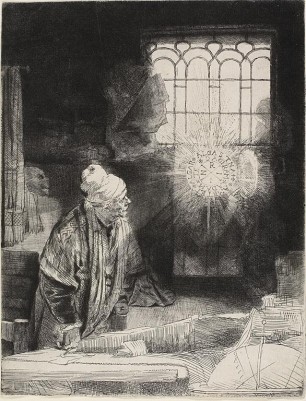If your Italian fails you while trying to read Leonardo da Vinci’s Codex Leicester, on display through August 30 at the MIA, it’s not you. Leonardo created his notebook with mirror writing, transcribing his sentences backward and right to left. Yet recognizing the trick behind Leonardo’s coded script requires only the slightest Sherlockian effort compared to the secrets hidden in artworks elsewhere in the museum. The artist behind The Little Buffoon (1542), pictured above, was the rapscallion Sebald Beham. Although a follower of Albrecht Dürer, his subjects were far bawdier. For this little fool stuck in a banderole, art historian Stephen H. Goddard has determined that Beham was punning on the German verb geris[s]en, which he says can mean to tear, draw, or write. Two possible interpretations for the inscription: “I have torn you” and “I have written on you that I have beshit myself.” In the Northern Renaissance, excrement could be a warning against lustful activities.

When viewed at a sharp angle, the distorted lines across most of Erhard Schön’s woodcut reveal the forbidden scene below.
In the 1530s, there was a craze for works with distorted lines that, when viewed from an extreme angle, resolved themselves into a secret image. The most famous use of this optical technique, called anamorphism, is Han Holbein’s 1533 painting The Ambassadors, at the National Gallery in London, with its hidden skull. (As it happens, Leonardo reportedly made the first mention of anamorphism, in his Codex Atlanticus of c. 1483-1518.)
In the “picture puzzle” woodcut (c. 1538) shown above, Dürer’s pupil Erhard Schön used anamorphism to disguise erotic subject matter. The small lefthand scene deals with the theme, famously illustrated by Dürer, of the “ill-assorted couple,” two people greatly different in age. This was a moralizing lesson to old men to beware of wily (and pickpocketing) young women. If you go to the MIA’s Print Study Room and stand at the print’s far left, the elongated lines in the rest of the print turn into a lewd scene with a nude threesome. The stretched-out letters also become clear: Aus, du alter tor! (Out, you old fool!)

Rembrandt’s Faust etching has much to do with divine inspiration and nothing to do with the Faust legend.
The mysterious glowing disk in Rembrandt’s Faust (The Scholar in His Study), c. 1652, has kept experts debating for centuries. All agree that INRI in the center refers to the monogram for Christ, derived from the Latin “Jesus Nazarenus Rex Judaeorum.” Other letter groupings can be traced to mystical words in the Kabbalah. The letters in the outermost ring are AMRTET ALGAR ALGASTNA. Rembrandt scholar H. van de Waal notes that the letters in reverse twice spell AGLA, which relates to a prayer in Jewish rites. He says AMRTET derives from Tetragrammaton, the Jewish name for God, while art historian Deni McIntosh McHenry proposes a connection to Metatron, an angel with mystical associations. Why this “crypto-magic,” as van de Waal calls it? Known to be religiously tolerant, Rembrandt may have wanted to be sensitive to a certain religion with this print, either because it was not welcome in Amsterdam, or because its rituals required secrecy.
The MIA’s impression of Cornelis Visscher’s The Ratcatcher (1655) is mesmerizing for the elegant lines spent depicting an inelegant profession. On the trademan’s wooden box, possibly containing rat-killing ferrets, Visscher secretly engraved emblems of the cities that bookended his short life: Haarlem, where he was supposedly born, in 1629, and Amsterdam, where he died 29 years later.
Sometimes script is simply coded for coolness. Graphic designer Wes Wilson was 29 when he created this psychedelic poster announcing the “Joint Show,” a San Francisco exhibition of psychedelic-poster artists. To save wear and tear on old hippie eyes, here is a deciphering of Wilson’s words:

A woman of many words: Artist Wes Wilson’s name appears on the figure’s breasts in this poster for an exhibition of psychedelic posters in July 1967.
Joint Show a moments grace for all those who live on the razors edge & a new spectre for those alive on the shores of the Pacific See Wes Wilson Victor Moscoso Stanley Mouse Alton Kelly and Rick Griffin in the flesh also Country Joe and the Fish Moore Galleries San Francisco Cal USA
Prints aren’t the only mysterious works at the MIA. An architectural element for the 1913 Purcell-Cutts House (Gallery 300) contains in its foliated motif the words “Gray Days & Gold,” a hidden reference to architect William Purcell’s beloved grandparents, William and Catherine Gray. The 20th-century painting Winter Count (Gallery 261) contains 106 pictographs, which together serve as a history for a community of Lakota Native Americans. Each drawing represents a year, starting in 1798, with a single event from that annum. Then there is the museum’s magnificent ode to vengeance, Girodet’s 1799 Portrait of Mlle. Lange as Danaë (Gallery 306), with several creatures disguised as the actress’s former lovers, and four delicious medallions in the frame that refer to her moral failings.

Girodet painted this lampoon of actress Mlle. Lange after she criticized his artistic abilities. The satyr and turkey allude to former lovers.
Sorry to say, nothing so dramatic was behind Leonardo’s mirror writing. Apparently he was left-handed, and this method was the most efficient way he knew to get his thoughts down in a hurry, and also spared his sleeve from dragging across the wet ink.



